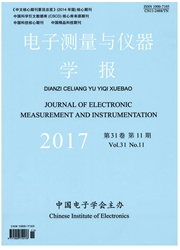

 中文摘要:
中文摘要:
经验模态分解(empirical mode decomposition,EMD)降低噪声的同时也削弱信号能量,并会产生虚假信号,导致信号检测存在缺陷,针对这一问题,提出Levy噪声环境下经验模态分解随机共振检测方法。通过将含噪信号进行EMD分解,对分解后信号进行叠加取平均二次采样等处理方法,使其满足随机共振要求,利用自适应算法优化系统参数,进而使处理后信号能够在双稳系统中产生随机共振,达到精确检测的目的。理论分析及实验证明在Levy噪声下,此方法能实现同一特征指数下单频信号与多频信号检测,实验表明在单频信号信噪比为-28 dB情况下能有14 dB的提高,特征指数为1.8下多频信号5 Hz频谱幅值从311.8增加到724,10 Hz频谱幅值由138.9增加到143.2。此方法对在复杂噪声环境中降低剩余噪声能量同时,提高信号能量,减少虚假信号,相对于仅仅进行EMD分解无法判断信号成分,能更好的达到检测效果。
 英文摘要:
英文摘要:
Empirical mode decomposition (EMD)method attenuates the signals' energy and generates false signals in decomposing signal noise, which leads to incorrect detection results. In order to solve this problem, a stochastic resonance method under Levy noise after denoised by EMD decomposition is presented in this paper. After decomposed by EMD, the noisy signals are handled by overlaying, averaging and resampling to meet the condition of stochastic resonance. An adaptive algorithm is used to optimize system parameters, and then the processed signal can generate stochastic resonance in bistable system to achieve precise detection. The theoretical analysis and experimental results prove that the method can detect single-frequency signal and multi-frequency signal under the same characteristic exponent with the Levy noise. The experimental results demonstrate that the SNR of single-frequency signal can increase 14 dB in the case of SNR of -28 dB. The spectral amplitude of the 5 Hz spectrum is increased from 311.8 to 724 and 10 Hz spectrum amplitude is increased from 138.9 to 143.2. This method that reduces the residual noise energy and false signal can improve the signal energy in a complex noisy condition. Compared to EMD decomposition which cannot determine the signal components, this method can achieve the detection effect better.
 同期刊论文项目
同期刊论文项目
 同项目期刊论文
同项目期刊论文
 期刊信息
期刊信息
